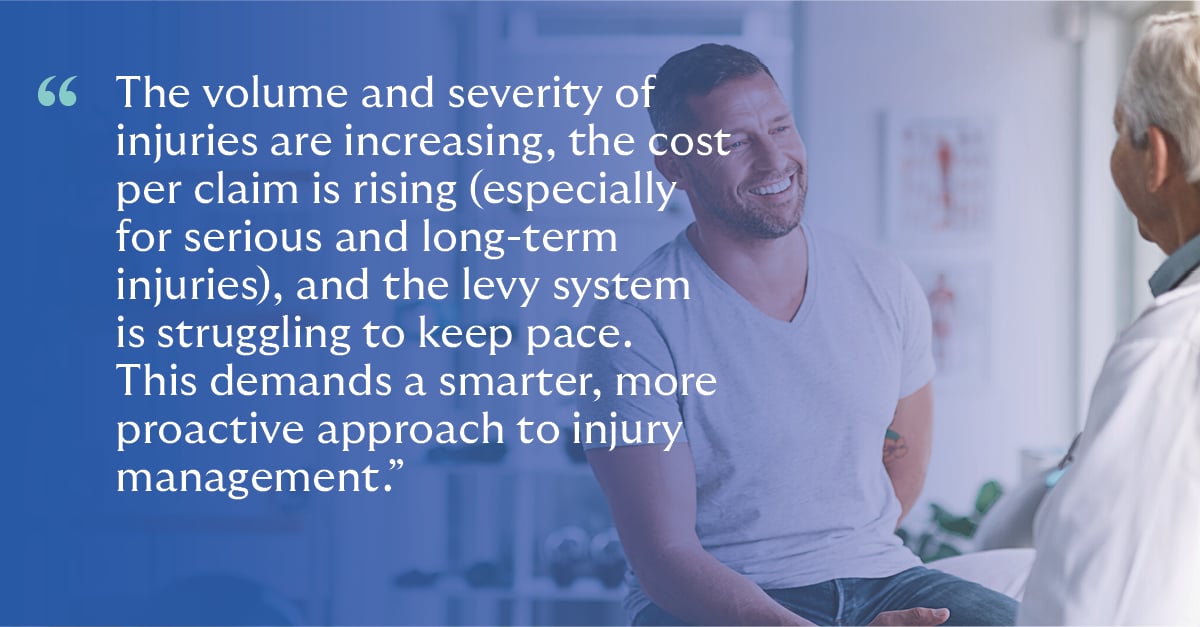The true cost of injury: time to rethink your injury prevention strategy
The true cost of injury: time to rethink your injury prevention strategy
In New Zealand, Accident Compensation Corporation (ACC) is the primary agency for managing both injury compensation and prevention. It is the Crown entity that administers New Zealand’s no-fault accident insurance scheme, which covers all residents and visitors who suffer a personal injury, regardless of how the injury occurred.1 Injury prevention is a crucial part of the scheme in the overall management of personal injuries, and the impact of these injuries on the community.
Pressure on the scheme is mounting
Each year ACC releases a report containing insights from injuries in New Zealand. The December 2024 report brought to light the growing complexities the scheme has faced in recent years, the most significant being the increasing claim volumes, the lower-than-expected rehabilitation performance and expansion of the scheme boundaries.2 This has been accompanied by a significant increase in levies. The ACC earners’ levy rose from 1.60% to 1.67% in 2024 and will rise 5% annually for the next two years.3 The report provides sufficient evidence that pressure on the scheme is rapidly mounting. From an employer perspective, and more broadly as a country, this seems unsustainable and requires deserved attention.
Rising costs mean rising levies…
The most significant trend to explain the increase in levies is the rate at which injury claims are rising, with over 2 million in 2024.4 There are also sizeable increases in recovery durations and costs of rehabilitation. For example, weekly compensation covered 18 million days off work last year, supporting 162,571 people who couldn’t work due to injury.5 The total spending reached $7 billion, with $4.4 billion allocated to treatment and rehabilitation, and $2.5 billion to income compensation.6 The declining rehabilitation rates and growing compensation costs mean the scheme is struggling to meet the demands of New Zealand’s population. This has contributed to a $7.23 billion deficit in the June-2024 financial year, driven by a 16% increase in injury services and compensation.7
This has prompted a response from the government that expresses concern about the sustainability of ACC’s funding and the effectiveness of rehabilitation interventions. At the end of last year, ACC Minister Matt Doocey acknowledged the decade-long decline and communicated the focus would be on strengthening performance monitoring and targeted rehabilitation services.8
Behind the numbers: what the 2024 report really tells us
A standout statistic of the 2024 Injuries in New Zealand Report is that the average amount of weekly compensation days for a work injury has now hit a staggering 127.9 The report doesn’t hide the fact that the current levies are set at a rate that cannot cover this, despite significant increases. There has been an explosive growth in costs, with treatment and rehabilitation costs increasing from just under $1 billion in 2004 to $4.4 billion in 2024.10 That’s a 340% increase over 20 years, outpacing inflation and population growth.
The areas that injuries are shown to most commonly occur are in the home and community, amounting to 66% of claims.11 The main reason being because these are traditionally more difficult to regulate or prevent. Additionally, sport and recreation accounted for 23% and workplace injuries for 10%.12
The demographic shift: how ageing is changing injury risk
The recent data shows that the severity of injuries has increased and therefore the amount of long-term support needed. The fact that New Zealand has an increasingly ageing population undoubtedly influences the injury patterns we’re observing. For example, the share of people aged 65 and over, which was 16% in 2022, is highly likely (90% probability) to rise to between 21% and 25% by 2048, and to between 24% and 32% by 2073.13 Elderly generations are more likely to succumb to injuries related to falls, have a higher mortality rate, and also introduce complex risk factors. Certain industries also involve higher risks and therefore higher costs of injuries such as construction, agriculture and manufacturing.

Who’s paying the price? The employer burden
One of the main consequences of the patterns shown in this report is that ultimately the response to injuries is getting far more costly. For someone earning $70,000, the ACC levy will increase by $42 in 2025, and $140 over three years.14 Small businesses and self-employed individuals are disproportionately affected, and for many this will cease to be sustainable.
New Zealand businesses will continue to face growing financial pressure as the rising cost of workplace injuries shows no signs of slowing.
In 2024 alone, workplace injuries accounted for 10% of all ACC claims but what’s notable is that they make up 21% of total recovery costs. This demonstrates the disproportionate financial burden on employers.
A smarter way forward: how the AEP can cut costs and boost control
The AEP (Accredited Employers Programme) offers employers in New Zealand a way to significantly reduce ACC levies, as much as 90%, through self-management of workplace injuries.15 This involves deciding on cover and entitlements for employees, paying for treatment, rehabilitation, and weekly compensation, supporting return-to-work programs and maintaining health and safety systems. The extent to which they reduce their work levy depends on their performance and plan type.16 Perhaps one of the key differentiators is that there is no experience rating, meaning that levies aren’t adjusted based off past years, which can offer financial protection in volatile years.
Self-management can lead to several benefits including highly specialised injury and illness management solutions to produce more positive return-to-work outcomes. It can also mean greater control and ease of access to information for employers, facilitating quicker decisions and focused customisation of rehabilitation plans. Finally, it offers enhanced visibility for employers, allowing them to gain better insight into injury patterns and adopt a more proactive approach to injury management. The outcomes for Accredited Employers (which include ACC) have consistently outperformed that of the standard scheme, both for employees and their employer. This explains why few employers leave the AEP scheme and more are choosing to join.
Conclusion
The 2024 Injuries in New Zealand Report represents a critical juncture in New Zealand’s ACC scheme. Rising claim volumes, escalating rehabilitation costs and an ageing population are placing significant pressure on the system, which has generated widespread concern over the sustainability of its future. Rising levies continue to impact both individuals and employers, demanding a re-evaluation of how we manage injury risk. Exploring alternatives such as the AEP presents employers with the opportunity to make significant financial savings and gain a clearer insight into workplace injury patterns. By adopting a customised prevention strategy, it allows for more positive injury management outcomes to be achieved.
Get in touch with us today

1Accident Compensation Corporation, Injuries in New Zealand 2024 (Wellington: ACC, 2024) <https://www.acc.co.nz/assets/injury-prevention/Injuries-in-New-Zealand-2024.pdf> [accessed 16 September 2025].
2Accident Compensation Corporation, Injuries in New Zealand 2024 (Wellington: ACC, 2024) <https://www.acc.co.nz/assets/injury-prevention/Injuries-in-New-Zealand-2024.pdf> [accessed 16 September 2025].
3Accident Compensation Corporation, Levy Guidebook 2025–2026: A Guide to ACC Levies for Employers, Self-Employed and Advisors (Wellington: ACC, 2025) <https://www.acc.co.nz/assets/business/Levy-Guidebook-2025-2026.pdf> [accessed 16 September 2025].
4Accident Compensation Corporation, Levy Guidebook 2025–2026: A Guide to ACC Levies for Employers, Self-Employed and Advisors (Wellington: ACC, 2025) <https://www.acc.co.nz/assets/business/Levy-Guidebook-2025-2026.pdf> [accessed 16 September 2025].
5Accident Compensation Corporation, Injuries in New Zealand 2024 (Wellington: ACC, 2024) <https://www.acc.co.nz/assets/injury-prevention/Injuries-in-New-Zealand-2024.pdf> [accessed 16 September 2025].
6New Zealand Treasury, Official Information Act Response 20250504 – Information on ACC, 23 September 2025, available at: <https://www.treasury.govt.nz/sites/default/files/2025-09/oia-20250504.pdf> [accessed 23 September 2025].
7Gareth Vaughan, ‘ACC Minister Matt Doocey Reveals Big Hikes in ACC Levies and Announces Review of Scheme’, interest.co.nz, 4 September 2024 <https://www.interest.co.nz/insurance/131234/acc-minister-matt-doocey-reveals-big-hikes-acc-levies-and-announces-review-scheme> [accessed 16 September 2025].
8Matt Doocey, ‘Independent Review of ACC Announced’, Beehive.govt.nz, 12 December 2024, <https://www.beehive.govt.nz/release/independent-review-acc-announced> [accessed 23 September 2025].
9Accident Compensation Corporation, Injuries in New Zealand 2024 (Wellington: ACC, 2024) <https://www.acc.co.nz/assets/injury-prevention/Injuries-in-New-Zealand-2024.pdf> [accessed 16 September 2025].
10Accident Compensation Corporation, Injuries in New Zealand 2024 (Wellington: ACC, 2024) <https://www.acc.co.nz/assets/injury-prevention/Injuries-in-New-Zealand-2024.pdf> [accessed 16 September 2025].
11Accident Compensation Corporation, Injuries in New Zealand 2024 (Wellington: ACC, 2024) <https://www.acc.co.nz/assets/injury-prevention/Injuries-in-New-Zealand-2024.pdf> [accessed 16 September 2025].
12Accident Compensation Corporation, Injuries in New Zealand 2024 (Wellington: ACC, 2024) <https://www.acc.co.nz/assets/injury-prevention/Injuries-in-New-Zealand-2024.pdf> [accessed 16 September 2025]
13Stats NZ, National Population Projections: 2022 (base)–2073, Stats NZ, 2022, <https://www.stats.govt.nz/information-releases/national-population-projections-2022base2073/> [accessed 16 September 2025].
14Accident Compensation Corporation, Levy Guidebook 2025–2026: A Guide to ACC Levies for Employers, Self-Employed and Advisors (Wellington: ACC, 2025) <https://www.acc.co.nz/assets/business/Levy-Guidebook-2025-2026.pdf> [accessed 16 September 2025].
15Accident Compensation Corporation, Accredited Employers Programme, ACC New Zealand, https://www.acc.co.nz/for-business/understanding-your-cover-options/accredited-employers-programme [accessed 16 September 2025].
16Accident Compensation Corporation, ‘Accredited Employers Programme’, ACC <https://www.acc.co.nz/for-business/understanding-your-cover-options/accredited-employers-programme> [accessed 16 September 2025].
